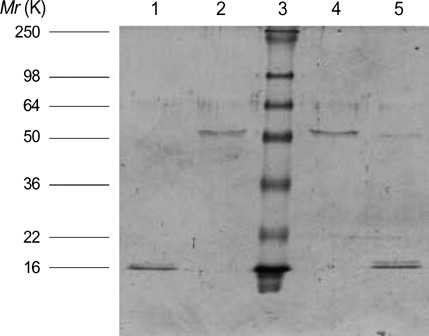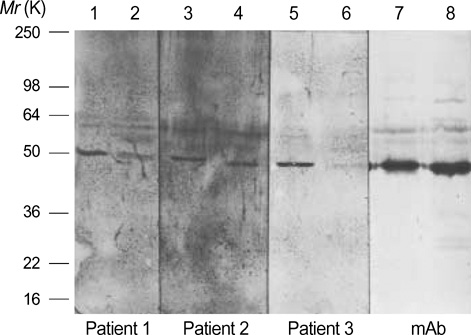J Korean Med Sci.
2006 Aug;21(4):652-655. 10.3346/jkms.2006.21.4.652.
Antigen-binding Characteristics of Circulating IgG Autoantibodies to Cytokeratin 18 Protein in Patients with Nonallergic Asthma
- Affiliations
-
- 1Department of Allergy and Rheumatology, Ajou University Hospital, Suwon, Korea. donghonahm@yahoo.co.kr
- 2Department of Pathology, Ajou University Hospital, Suwon, Korea.
- KMID: 2157816
- DOI: http://doi.org/10.3346/jkms.2006.21.4.652
Abstract
- Cytokeratin 18 (CK18) protein was identified as an airway epithelial cell autoantigen associated with nonallergic asthma. Cleavage of CK18 protein by caspase-3 is a marker of early apoptosis in epithelial cells. It has been shown that the expression of active caspase-3 was increased in bronchial epithelial cells of asthmatic patients, when compared with healthy controls. To investigate the antigen-binding characteristics of IgG autoantibodies to CK18 protein in nonallergic asthma, the bindings of IgG autoantibodies to the fragments of CK18 protein cleaved by caspase-3 were analyzed by Western blot using serum samples from three patients with nonallergic asthma. Recombinant human CK18 protein was treated by caspase-3 and cleaved into N-terminal fragment (1-397 amino acids) and C-terminal fragment (398-430 amino acids). The binding capacity of IgG autoantibodies to N-terminal fragment of CK18 was maintained in one patient and reduced in other two patients. IgG autoantibodies from all three patients did not bind to C-terminal fragment of CK 18. In conclusion, IgG autoantibodies to CK18 protein from patients with nonallergic asthma seems to preferentially bind to the whole molecule of CK18 protein and their antigen-binding characteristics were heterogeneous among the patients with nonallergic asthma.
Keyword
MeSH Terms
-
Protein Binding
Peptide Fragments/immunology/metabolism
Male
Keratins/chemistry/*immunology/metabolism
Immunoglobulin G/blood/*immunology/metabolism
Hydrolysis
Humans
Female
Epitopes/immunology/metabolism
Caspases/metabolism
Caspase 3
Blotting, Western
Autoantibodies/blood/*immunology/metabolism
Asthma/*blood/immunology
Antigen-Antibody Reactions
Antibodies, Monoclonal/immunology/metabolism
Aged
Adult
Figure
Reference
-
1. Global Initiative for Asthma: Global strategy for asthma management and prevention. 2002. Bethesda, Md: National Institutes of Health;50–66. (NIH publication no. 02-3659.).2. Keeney EL. The history of asthma from Hippocrates to Meltzer. J Allergy Clin Immunol. 1964. 35:215–226.
Article3. Pearce N, Pekkanen J, Beasley R. How much asthma is really attributable to atopy. Thorax. 1999. 54:268–272.
Article4. The ENFUMOSA Study Group. The ENFUMOSA cross-sectional European multicentre study of the clinical phenotype of chronic severe asthma. Eur Respir J. 2003. 22:470–477.5. Wagner V, Tomšíková A, Šach J, Janková J, Novácková D. Autoimmune mechanism in diseases of the respiratory tract. Acta Allergol. 1965. 20:1–9.
Article6. Girard JP, Dami J. Antigenic properties of lung tissue. Presence of specific antibodies in certain chronic respiratory disorders. Poumon Coeur. 1973. 29:267–270.7. Lassalle P, Delneste Y, Gosset P, Gras-Masse H, Wallaert B, Tonnel AB. T and B cell immune response to a 55-kDa endothelial cell-derived antigen in severe asthma. Eur J Immunol. 1993. 23:796–803.
Article8. Rottem M, Shoenfeld Y. Asthma as a paradigm for autoimmune disease. Int Arch Allergy Immunol. 2003. 132:210–214.
Article9. Montefort S, Herbert CA, Robinson C, Holgate ST. The bronchial epithelium as a target for inflammatory attack in asthma. Clin Exp Allergy. 1992. 22:511–520.
Article10. Nahm DH, Lee YE, Yim EJ, Park HS, Yim H, Kang Y, Kim JK. Identification of cytokeratin 18 as a bronchial epithelial autoantigen associated with nonallergic asthma. Am J Respir Crit Care Med. 2002. 165:1536–1539.
Article11. Trautmann A, Kruger K, Akdis M, Muller-Wening D, Akkaya A, Brocker EB, Blaser K, Akdis CA. Apoptosis and loss of adhesion of bronchial epithelial cells in asthma. Int Arch Allergy Immunol. 2005. 138:142–150.
Article12. Grutter MG. Caspases: key players in programmed cell death. Curr Opin Struct Biol. 2000. 10:649–655.13. Leers MP, Kolgen W, Bjorklund V, Bergman T, Tribbick G, Persson B, Bjorklund P, Ramaekers FC, Bjorklund B, Nap M, Jornvall H, Schutte B. Immunocytochemical detection and mapping of a cytokeratin 18 neo-epitope exposed during early apoptosis. J Pathol. 1999. 187:567–572.
Article14. Benayoun L, Letuve S, Druilhe A, Boczkowski J, Dombret MC, Mechighel P, Megret J, Leseche G, Aubier M, Pretolani M. Regulation of peroxisome proliferator-activated receptor gamma expression in human asthmatic airways: relationship with proliferation, apoptosis, and airway remodeling. Am J Respir Crit Care Med. 2001. 164:1487–1494.15. Ditzel HJ, Strik MC, Larsen MK, Willis AC, Waseem A, Kejling K, Jensenius JC. Cancer-associated cleavage of cytokeratin 8/18 heterotypic complexes exposes a neoepitope in human adenocarcinomas. J Biol Chem. 2002. 277:21712–21722.
Article16. Caulin C, Salvesen GS, Oshima RG. Caspase cleavage of keratin 18 and reorganization of intermediate filaments during epithelial cell apoptosis. J Cell Biol. 1997. 138:1379–1394.17. Puddicombe SM, Polosa R, Richter A, Krishna MT, Howarth PH, Holgate ST, Davies DE. Involvement of the epidermal growth factor receptor in epithelial repair in asthma. FASEB J. 2000. 14:1362–1374.
Article18. Iwata A, Nishio K, Winn RK, Chi EY, Henderson WR Jr, Harlan JM. A broad-spectrum caspase inhibitor attenuates allergic airway inflammation in murine asthma model. J Immunol. 2003. 170:3386–3391.
Article19. Wen LP, Madani K, Fahrni JA, Duncan SR, Rosen GD. Dexamethasone inhibits lung epithelial cell apoptosis induced by IFN-gamma and Fas. Am J Physiol. 1997. 273:L921–L929.20. Dobashi N, Fujita J, Murota M, Ohtsuki Y, Yamadori I, Yoshinouchi T, Ueda R, Bandoh S, Kamei T, Nishioka M, Ishida T, Takahara J. Elevation of anti-cytokeratin 18 antibody and circulating cytokeratin 18: anti-cytokeratin 18 antibody immune complexes in sera of patients with idiopathic pulmonary fibrosis. Lung. 2000. 178:171–179.
Article21. Umibe T, Kita Y, Nakao A, Nakajima H, Fukuda T, Yoshida S, Sakamaki T, Saito Y, Iwamoto I. Clonal expansion of T cells infiltrating in the airways of non-atopic asthmatics. Clin Exp Immunol. 2000. 119:390–397.
Article22. Kon OM, Kay AB. Anti-T cell strategies in asthma. Inflamm Res. 1999. 48:516–523.
Article23. De Sanctis GT, Itoh A, Green FH, Qin S, Kimura T, Grobholz JK, Martin TR, Maki T, Drazen JM. T-lymphocytes regulate genetically determined airway hyperresponsiveness in mice. Nat Med. 1997. 3:460–462.
Article24. Taraseviciene-Stewart L, Scerbavicius R, Choe KH, Moore M, Sullivan A, Nicolls MR, Fontenot AP, Tuder RM, Voelkel NF. An animal model of autoimmune emphysema. Am J Respir Crit Care Med. 2005. 171:734–742.
Article25. Nahm DH. Pathogenetic mechanism of nonallergic asthma: autoimmune hypothesis. Korean J Asthma Allergy Clin Immunol. 2004. 24:69–74.
- Full Text Links
- Actions
-
Cited
- CITED
-
- Close
- Share
- Similar articles
-
- Association between IgG Autoantibodies to Cytokeratin 18 Protein and Clinical Severity in Adult Asthmatic Patients
- IgG Subclass Distribution of Circulating IgG Autoantibodies to Airway Epithelial Cell Proteins in Adult Asthmatic Patients
- Analysis of Airway Epithelial Cell Autoantigens Recognized by IgG Autoantibodies from Patients with Severe Asthma and Chronic Obstructive Pulmonary Disease
- Circulating Autoantibodies in Patients with Aspirin-intolerant Asthma: An Epiphenomenon Related to Airway Inflammation
- Isotype and IgG Subclass Distribution of Autoantibody Response to Alpha-enolase Protein in Adult Patients with Severe Asthma




